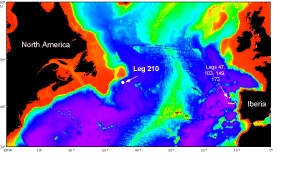
Downhole Logging Summary
Leg 210 Shipboard Scientific Party
Drilling Leg 210 was designed to study the history of rifting and postrift sedimentation in the Newfoundland-Iberia rift (Tucholke, Sibuet, Klaus et al., 2004). Two holes were drilled in the Newfoundland Basin (Sites 1276-1277; Fig. 1) along a transect conjugate to previous drilling on the Iberia margin (Legs 149 and 173). A major goal of Leg 210 was to investigate the nature of the basement (continental or oceanic) and sample the basin-wide reflection U observed immediately above basement in seismic reflection profiles (Fig. 2).
After installing a re-entry cone and casing the upper 800 m, Hole 1276A was cored from 800 to 1739 mbsf with excellent recovery (average of 85%). Five lithologic units were recognized, ranging in age from uppermost Albian-Aptian(?) to Eocene. The sedimentary succession consists of background hemipelagic mudrocks with various proportions of interbedded gravity-flow deposits. Hole 1276A terminated in diabase sills.
Hole 1277A was drilled into a basement high ~40 km southeast of Site 1276. In this hole an assemblage of a calcite-cemented conglomerate, basalts, and gabbros was recovered above a section of serpentinized peridotites that appear to represent true basement. These rocks were emplaced in a magma-limited, highly extensional environment and they are interpreted as very slow spreading oceanic crust.
Preliminary results are found at http://www-odp.tamu.edu/publications/prelim/210_prel/210toc.html
Figure 1. Location map of the Newfoundland Basin and the Leg 210 drill sites.
Figure 2. Simplified seismic interpretation and position of Sites 1276 and 1277.
Hole 1276A
The logging operation turned out to be more difficult than originally anticipated. An attempt to log the section cored between 1350 mbsf and the base of casing at 800 mbsf was unsuccessful because of closure of the hole. Even after the pipe was lowered well below the casing, the logging tools could not exit the drill pipe. Further logging opportunities were few and far between as the hole continued to close on the drill string during drilling and coring operations. The drillers identified numerous tight spots and the hole had to be wiped repeatedly; these tight-hole conditions would have caused problems for the passage of the logging tools. Any remaining hope for logging were abandoned when the drill pipe became tightly wedged in the hole after reaching the final depth of 1739 mbsf.
Downhole activities on Leg 210 also included the deployment of the retrievable memory module (RMM), which is a modified drillstring accelerometer tool deployed with the core barrel. The main purpose of the RMM is to receive and store data transmitted from an instrumented drill collar known as the downhole sensor sub (DSS) in the bottom hole assembly. The DSS measures drilling parameters such as weight on bit, torque, pressure, and temperature. These data are stored in the DSS but are also transmitted to the RMM after it lands with the core barrel at the bit. Additionally, the RMM can measure drilling parameters such as pressure and acceleration. During Leg 210, data were successfully retrieved from the RMM and transferred to Texas A&M University and Lamont engineers. As indicated in Figure 3, the RMM data show that it is possible to identify the time that the RMM landed by the Z (vertical) acceleration spike that marks its impact at the drill bit. Thereafter, vertical accelerations mark 'jumping' of the drill bit when drilling resumed.
Figure 3. At-the-bit acceleration data recorded with the RMM.
Reference
Srivastava S.P., Sibuet J.-C., Cande S., Roest W.R. and Reid I.R. (2000) Magnetic evidence for slow seafloor spreading during the formation of the Newfoundland and Iberian margins. Earth Planet. Sci. Lett., 182:61-76.
Tucholke B.E., Sibuet J.-C., Klaus A. and Shipboard Scientific Party (2004) Proc. ODP, Init. Repts., 210: College Station, TX (Ocean Drilling Program).
ODP Logging Staff Scientist
Heike Delius, University of Leicester, Dept of Geology, Leicester LE1 7RH, UK